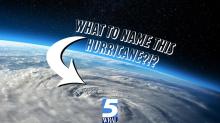- Southport hosts annual Hurricane Expo ahead of the 2024 season
- How to protect your car before a hailstorm
- ‘We lost everything’: East Texas residents confront their future after flooding
- Here's how to get your flooding debris picked up by the City of Houston
- Mosquito activity on the rise due to rainfall, flooding across Texas
Tracking the tropics: When and where the next Atlantic hurricane or tropical storm will form

Tracking the tropics 2022 | Your source for hurricane and tropical storm watch updates
Staying ahead of current tropical storms and hurricanes is crucial. Not only do you have to be prepared for any damage that might occur, but you mentally and physically need to be ready for whatever happens next. Staying ahead of the curve means knowing every upcoming storm and how it is tracking. The WRAL Severe Weather Center is tracking the tropics to help you and your family be ready for any scenario.
Tropical storms now
“There is nothing tropical headed our way for the holiday weekend,” WRAL meteorologist Elizabeth Gardner says.
While the North Carolina coast is in the clear, there are three systems to watch.
Mid-week threat to the Caribbean
A tropical wave that came off the African coast last week is on track for the Caribbean Sea. It would become Bonnie should it reach tropical storm status.
The National Hurricane Center identified Potential Tropical Cyclone No. 2 on Monday. That system has a 20% chance to develop over the next five days. In naming it “potential tropical cyclone,” the hurricane center can begin to issue advisories and forecast storm tracks.
This storm moving west-northwest at 18 mph with top winds at 40 mph. It is expected to make its way into the Caribbean by mid-week, passing over Aruba and Curacao and Bonaire and then eventually making its way into the southwestern Caribbean, perhaps becoming the season’s first hurricane.
System in Gulf of Mexico could bring rain to Deep South
In the western Gulf of Mexico, just off the coast of Texas, lies another system that could also strengthen in the coming days.
The ensemble models show it could develop into a tropical storm in the coming days.
“It would bring beneficial rains because much of Texas is under a drought right now and they could certainly use the rain,” said WRAL meteorologist Mike Maze.
“After it moves into Texas, some of the energy may make its way throughout the deep south. But I don’t see it coming here to North Carolina.
Another system, currently far out in the Atlantic, has a 90% chance of developing into a tropical storm in the next five days, and a 70% chance of getting a name by Wednesday. It is on a track toward the north coast of South America and toward central America.
What is the next name on the hurricane list?
Whenever the next tropical depression or tropical storm forms, it would be named Bonnie, followed by Colin, Danielle, Earl and Fiona.
Forecasters at NOAA’s Climate Prediction Center, a division of the National Weather Service, are predicting 14 to 21 named storms in 2022, with 6 to 10 reaching hurricane strength (winds of 74 mph or higher) and 3 to 6 of those becoming major hurricanes (category 3, 4 or 5; with winds of 111 mph or higher).
How to prepare for hurricane season
From late spring through the fall, there is always the chance that a hurricane will form in the Atlantic Ocean and impact North Carolina. While rough surf and overwash is a danger along the coast, hurricanes can bring torrential downpours, inland flooding, downed trees and even tornadoes to the Triangle.
It always pays to be prepared for a storm that can knock out power with a survival kit that includes non-perishable food, cash and plenty of clean, bottled water.
Worst hurricanes in North Carolina history
In fact, one of North Carolina’s most destructive hurricanes, Hurricane Fran in September 1996, blasted the Triangle with winds at near-hurricane strength. It left a landscape littered without trees in virtually every neighborhood and power outages that lasted for more than a week.
Hurricane Floyd in September 1999 inundated eastern North Carolina, including Rocky Mount, Wilson, Tarboro and Princeville, and put entire communities under water. The storm destroyed more than 8,000 homes and damaged 67,000 more.
In October 2016, Hurricane Matthew skirted the coast but generated devastating flooding across central and eastern North Carolina. The hurricane dumped more than a foot of rain 100 miles inland, swelling streams and rivers to levels above what Hurricane Floyd produced in 1999.
Hurricane Florence, in September 2018, brought a record 8.27-foot storm surge. Over the next three days, it produced up to 30 inches of rainfall over eastern North Carolina. Interstates 95 and 40 were both closed due to flooding, and 42 people died across the state.
